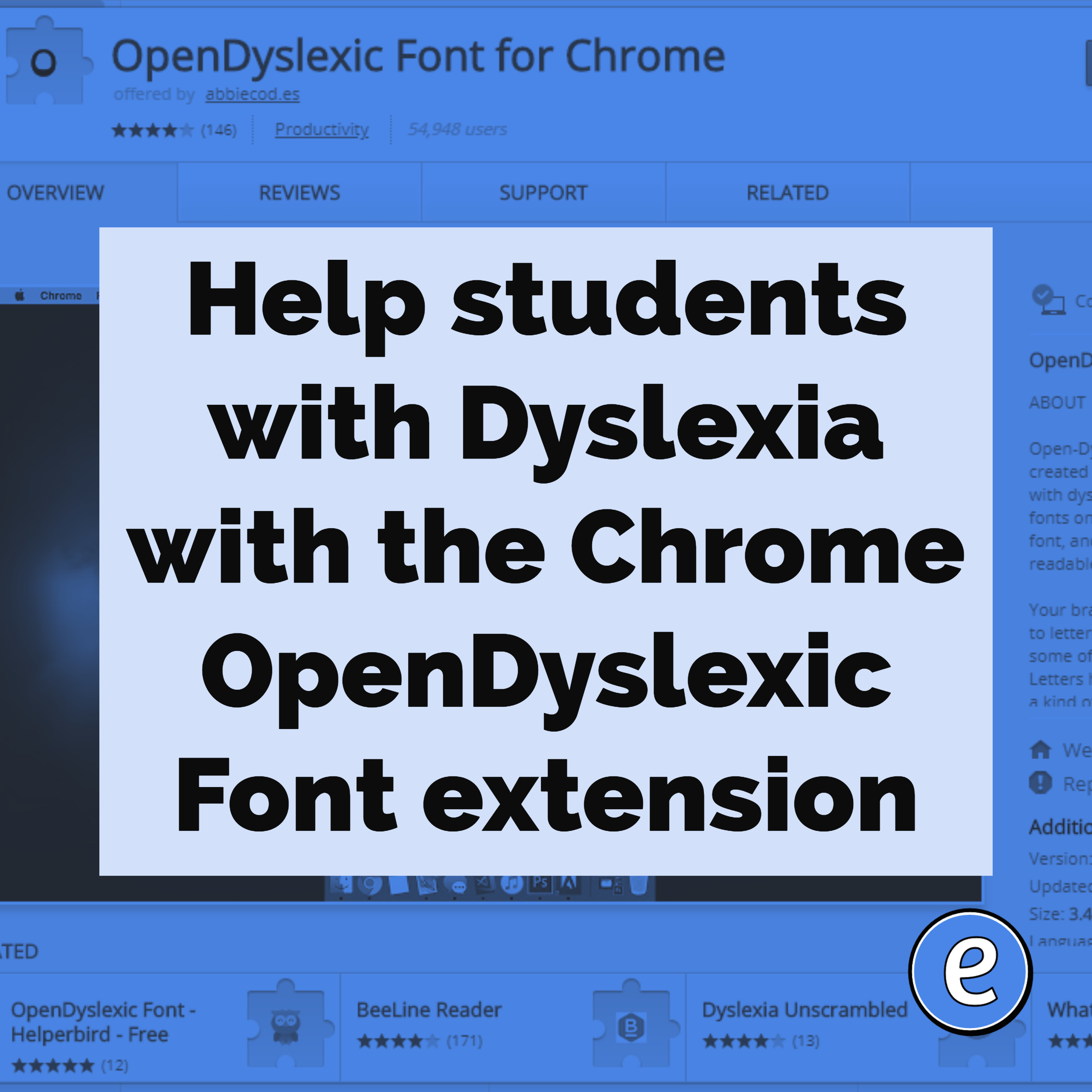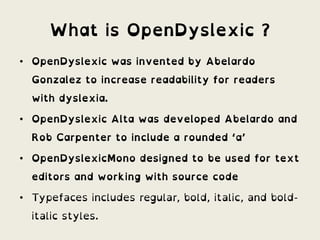What is OpenDyslexic Software?
OpenDyslexic software is a groundbreaking solution designed to improve the reading experience for individuals with dyslexia. The software primarily features a unique font that addresses specific reading challenges faced by dyslexic users. The OpenDyslexic font, created by Abelardo Gonzalez, is designed to mitigate common dyslexia symptoms such as letter reversals, crowding, and rotation.
The font’s design includes heavy weighted bottoms to provide a more robust foundation for each letter, making it easier for the reader to distinguish between individual characters. Additionally, the unique shapes of the letters and words help reduce the likelihood of letter substitution and misinterpretation. OpenDyslexic software also offers adjustable spacing between letters, words, and lines, allowing users to customize the layout to their preferences and improve overall reading fluency.
How OpenDyslexic Software Improves Reading Experience
OpenDyslexic software significantly enhances the reading experience for dyslexic users by addressing common issues such as letter recognition, word spacing, and reading fluency. The unique design features of the OpenDyslexic font help users distinguish between individual characters, reducing the likelihood of letter reversals, substitutions, and misinterpretations.
One of the primary advantages of OpenDyslexic software is its ability to improve letter recognition. The font’s heavy weighted bottoms and unique letter shapes provide a more robust foundation for each character, making it easier for dyslexic readers to identify and differentiate between letters. Additionally, OpenDyslexic software offers adjustable letter spacing, which further reduces letter crowding and minimizes the risk of misinterpretation.
Word spacing and line spacing are also crucial factors in improving the reading experience for dyslexic users. OpenDyslexic software allows for customizable word and line spacing, enabling users to find the optimal layout for their needs. Improved word and line spacing contribute to enhanced reading fluency, as it becomes easier for readers to recognize words and track lines of text. This, in turn, leads to increased overall reading speed and comprehension.
OpenDyslexic Software in Education
OpenDyslexic software plays a significant role in educational settings, providing a valuable resource for dyslexic students and educators alike. By integrating the OpenDyslexic font into learning management systems, e-readers, and digital textbooks, educational institutions can create a more inclusive and accessible learning environment.
Learning management systems (LMS) often serve as the central hub for course materials, assignments, and communication in educational settings. Integrating OpenDyslexic software into an LMS allows dyslexic students to access course content using the specialized font, making it easier for them to engage with the material and perform academically. Additionally, LMS administrators can customize font and spacing settings, enabling students to tailor the interface to their individual needs.
E-readers and digital textbooks are other areas where OpenDyslexic software can significantly improve the reading experience for dyslexic users. By offering the option to switch between standard and OpenDyslexic fonts, e-readers and digital textbook platforms can cater to a broader range of users, ensuring that all students have equal access to educational resources. Furthermore, adjustable line and word spacing options can be incorporated into e-reader and digital textbook interfaces, further enhancing the reading experience for dyslexic users.
Real-Life Applications of OpenDyslexic Software
OpenDyslexic software has been successfully implemented in various real-life applications, improving accessibility for dyslexic users in various contexts. Some examples of these applications include websites, apps, and e-books that utilize the OpenDyslexic font to enhance readability and user experience.
Websites catering to a wide range of audiences, from news outlets to blogs, have integrated OpenDyslexic software to ensure their content is accessible to all users. By offering the option to switch to the OpenDyslexic font and adjust spacing settings, these websites demonstrate a commitment to inclusivity and demonstrate the practicality of implementing OpenDyslexic software in real-world applications.
Mobile apps and digital platforms have also adopted OpenDyslexic software to improve their accessibility features. For instance, e-book readers and productivity apps often include the OpenDyslexic font as an option, allowing users to customize their reading experience according to their preferences and needs. Furthermore, some educational apps and resources have integrated OpenDyslexic software to create a more inclusive learning environment for dyslexic students.
Comparing OpenDyslexic Software to Other Accessibility Tools
OpenDyslexic software is one of several accessibility tools and fonts designed to improve the reading experience for dyslexic users. While there are other options available, OpenDyslexic software offers unique advantages and features that set it apart from the competition.
One such alternative is the dyslexie font, which shares similar goals with OpenDyslexic software. However, the dyslexie font focuses on altering the shapes of individual letters to create distinct and easily recognizable characters. While this approach can be effective, it may not cater to all dyslexic users, as some individuals may still struggle with letter recognition.
In contrast, OpenDyslexic software combines unique letter shapes with heavy weighted bottoms, providing a more robust foundation for each character. This dual-approach design allows OpenDyslexic software to address various dyslexia-related challenges, such as letter reversals, crowding, and rotation. Additionally, OpenDyslexic software offers adjustable spacing options, which can be customized to suit individual user preferences and needs.
How to Implement OpenDyslexic Software in Your Projects
Implementing OpenDyslexic software in your projects can significantly improve accessibility for dyslexic users. Here is a step-by-step guide on how to incorporate OpenDyslexic software in various projects, including websites, apps, and documents, with practical examples and code snippets.
Websites
To implement OpenDyslexic software on a website, you can utilize the @font-face CSS rule to import the OpenDyslexic font files and apply them to specific HTML elements. For example:
/* Import OpenDyslexic font files */ @font-face { font-family: 'OpenDyslexic'; src: url('path/to/opendyslexic-regular.woff2') format('woff2'), url('path/to/opendyslexic-regular.woff') format('woff'); font-weight: normal; font-style: normal; } /* Apply OpenDyslexic font to HTML elements */
body {
font-family: 'OpenDyslexic', sans-serif;
}
Apps
For mobile apps and digital platforms, you can integrate OpenDyslexic software by including the font files in your project and referencing them within your app’s code. For instance, in a native Android application, you can add the OpenDyslexic font files to the res/font/ directory and reference them in your layout XML files or programmatically using the Typeface class.
Documents
To use OpenDyslexic software in documents, you can download and install the OpenDyslexic font files on your computer and select the font within your preferred word processing or design software. For example, in Microsoft Word, you can choose the OpenDyslexic font from the dropdown menu and adjust the font size and spacing as needed.
Best Practices for Using OpenDyslexic Software
OpenDyslexic software can significantly improve the reading experience for dyslexic users when used effectively. Here are some best practices for utilizing OpenDyslexic software, including pairing it with other accessibility features, optimizing font size and spacing, and testing with dyslexic users.
Pairing with Other Accessibility Features
While OpenDyslexic software can greatly benefit dyslexic readers, it is essential to consider other accessibility features that can further enhance the reading experience. For instance, you can combine OpenDyslexic software with text-to-speech technology, allowing users to listen to the content while reading it. Additionally, incorporating features such as adjustable reading speeds, highlighting, and keyboard navigation can cater to a broader range of user preferences and needs.
Optimizing Font Size and Spacing
Properly adjusting font size and spacing is crucial when implementing OpenDyslexic software. Dyslexic users may benefit from larger font sizes and increased line and word spacing, which can improve letter recognition, word separation, and overall reading fluency. Experiment with different font sizes and spacing settings to determine the optimal layout for your project.
Testing with Dyslexic Users
To ensure that OpenDyslexic software is effectively improving the reading experience for dyslexic users, it is essential to test your project with individuals who have dyslexia. Gather feedback on the font’s readability, the overall layout, and any additional features that could further enhance the user experience. Utilize this feedback to make any necessary adjustments and fine-tune your implementation of OpenDyslexic software.
Future Developments and Enhancements for OpenDyslexic Software
OpenDyslexic software has the potential to further improve the reading experience for dyslexic users through innovative developments and enhancements. By integrating artificial intelligence, voice recognition, and gamification, OpenDyslexic software can cater to an even broader range of user preferences and needs.
Integration with Artificial Intelligence
Artificial intelligence (AI) can be employed to analyze user reading patterns and preferences, allowing OpenDyslexic software to dynamically adjust font size, spacing, and layout in real-time. This personalized approach can significantly enhance the reading experience for dyslexic users by catering to their unique needs and abilities.
Voice Recognition
Voice recognition technology can be used in conjunction with OpenDyslexic software to create a more interactive and immersive reading experience. By enabling users to read along with the text using voice recognition, they can improve their pronunciation, fluency, and overall reading skills. Additionally, voice recognition can help users navigate through documents and e-books more efficiently, reducing the cognitive load associated with traditional text navigation.
Gamification
Gamification elements, such as rewards, challenges, and progress tracking, can be incorporated into OpenDyslexic software to create a more engaging and motivating reading experience for dyslexic users. By turning reading into a game, users can develop a stronger connection with the content, leading to improved reading comprehension and fluency over time.







